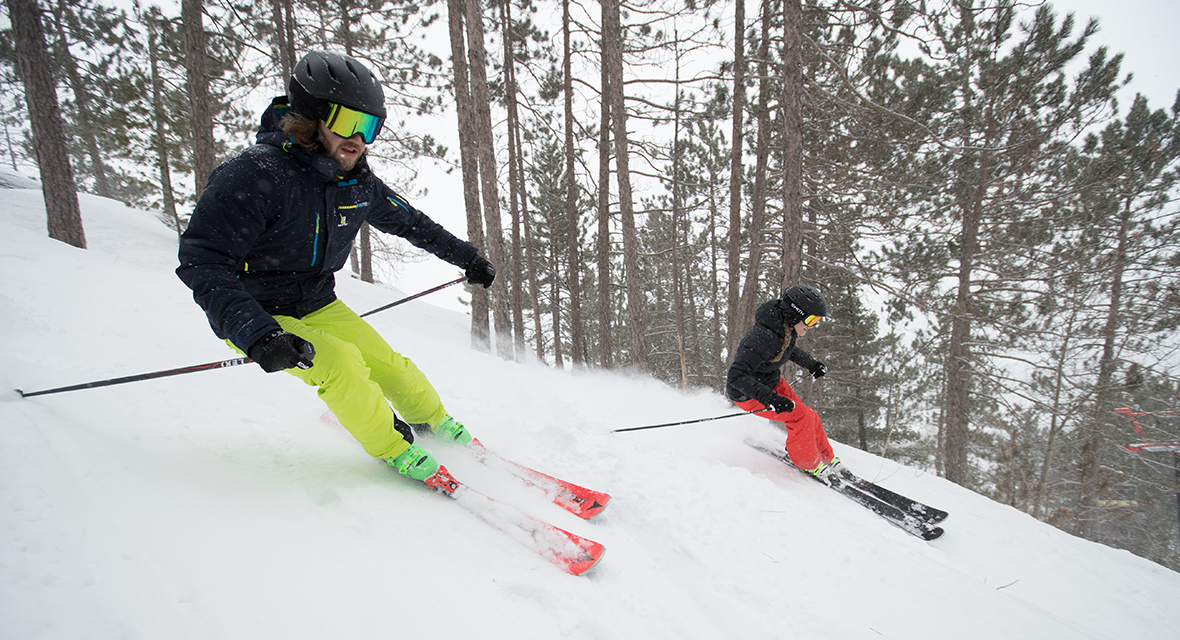
Choosing the best downhill ski equipment for you
One of the great joys of winter’s return is the thrill of skiing. It’s absolutely essential, however, to get yourself geared up properly. This means selecting your boots and skis with care to ensure comfort, safety and performance. Check out the guide before you hit the slopes!
Decide your skier’s profile
What kind of skier are you? That’s the big question when choosing your ski equipment. Are you just starting out, or have you always been a ski bum? Do you want to ski only groomed slopes, or are you ready to take on all types of terrain?
Determine first how and where you’d like to ski. Then hit the store ready to select the ideal ski equipment for your profile.
Find the best ski boots
The size
Ski boots sizes are established according to the international centimetre-based Mondo system. The size you choose depends on the length of your foot rounded down (for example, size 27.4 to 27), as the inner sole settles in with use. The width of the foot also matters and is measured in “last width”, with adult boots classified as narrow (96-99 mm), medium (100-103 mm) and wide (104 mm and over).
The tighter the fit, the better the performance, which is why you want to step up from a generic inner liner to a thermoformed foam liner that molds to your feet on first use. In fact, the outer boot shell can be made to perfectly fit your feet too. Ideally, you’ll have your new boots molded to fit your feet using a custom boot-fitting service, which a number of Sports Experts stores offer. You can consult the list here.
Stiffness
Your profile will help determine the degree of boot stiffness that best suits you. Experienced skiers prefer a very stiff boot with little flex to transfer more energy to the skis, even though this requires more strength, whereas beginners or more leisurely skiers might choose a softer flex for good times on groomed runs.
Adjustment
Slip on the boot and let the salesperson adjust the buckles and the power strap at the top. Separate your feet to hip width and flex your feet repeatedly.
- When you stand straight, your toes should just touch the ends of the boots. if this is not the case, go a size smaller. When you bend into a ski crouch, the heel should touch the back, while the toes should move back just a little, still snug to the front. If not, go for a higher size.
- If the foot feels cramped, choose a larger shell
- The sole is the where most of the comfort comes from, so choose one that can be custom fitted.
- Last but not least, the choice of the socks is essential: if they’re too thick, they compress the feet and reduce blood circulation, making them feel cold, which is definitely not what you want.
Choosing your skis
The category
Now that you know your style, you can determine which of these four main categories of downhill skis suits you: skis for groomed runs, often called carving or on-piste skis; skis for mixed conditions, called all-mountain skis; freeride or off-piste skis for powder; and freestyle skis for those who get their kicks at snow parks.
Flex
Each of the categories mentioned above includes sub-categories for different skill levels. If you’re a beginner to intermediate skier who prefers groomed runs, for example, you’ll want to look into sport or recreational models specifically designed for the carving category. These skis are often easier to maneuver and turn on, as they are more flexible – in fact, this capability is measured as “flex”. The flex of high-performance models, for example, is more rigid and requires more strength and technique to maneuver and turn.
Length
There is no strict rule, but the length of the ski is often determined according to your size, your skill level and quite simply your preference, as the shorter the skis, the more maneuverable they are, and the longer they are, the more stable.
Turning radius
The turning radius of the skis is measured as “sidecut”. For quicker turns, you’ll want skis with a shorter turning radius (under 16 metres), while if you like speed and wider turns, go for a longer radius model.
Completing your equipment
Next up is the rest of your gear. Choose the bindings, which are often included with the skis, and well-adjusted poles to give you optimum stability in all conditions. A good helmet and goggles mean always safe and secure skiing. As for the indispensable gloves, choose them with care so that they’re both warm and comfortable.
With so many details to consider when shopping for your ski equipment, take your time and don’t hesitate to ask the advice of the salespeople. Investing in high-quality gear is truly worth it to ensure safe skiing and have mountains of fun!











